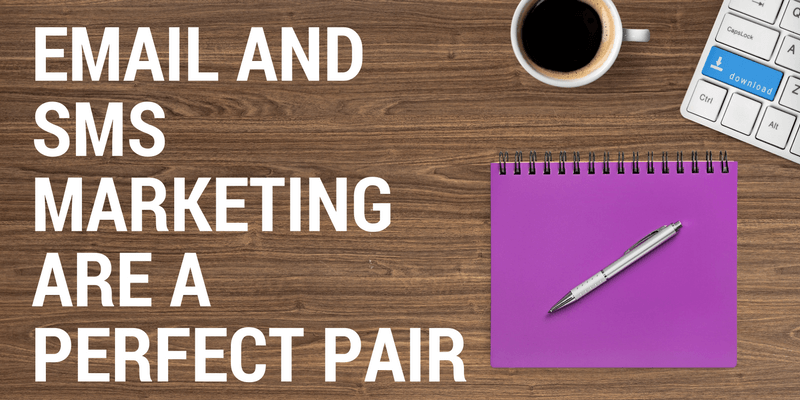Email and SMS Marketing are a Perfect Pair

Businesses with limited staff or budgets might ask themselves whether they should use email or SMS marketing. Both are relatively low cost. Furthermore each offers the ability to reach many people at the same time, yet provide personal interaction. SMS and email have a long history of being used for marketing.
The reason though, that it’s hard to decide is because they both work. But they are each good at different things. And that’s why they complement each other really well. So perhaps the only decision to be made is to use both of them.
For example, emails are great for longer content or extended campaigns. Statistics from Hubspot show that sending 16-30 email campaigns a month results in the highest click through rates. If you send that frequently, you can expect open rates of about 32% and click through rates of just over 6%. Not too bad for emails actually considering how full the average email inbox is. That’s why just sending one or two emails isn’t enough anymore – you need to keep your email in front of users.
In contrast, SMS messaging is better for short content. Open rates are at or above 99% and click through rates can average 36%. But users expect fewer messages via text. If you send more than six per month, users will start identifying you as spam or unsubscribe. So for text messaging, you send less often and only when the message is relevant or important to the users.
Given their differences described here, you might still think it’s ok to use one or the other. And of course it’s ok to do that, but if you can coordinate and use them both you’ll likely get better results than using just one. Here are the a few examples of how to use them together.
Double opt in campaign
Both email and SMS marketing are permission based. So you’ll need to get consent to send either. But once you have someone on one list, you can start promoting the other list. For example, you can ask someone in an SMS message for their email so they can join your email list. They can reply directly with their email, or you could send a link where they can sign up on a mobile friendly website.
Alternatively, if someone signs up for your email list, you can ask them to sign up for your SMS list.
You can send specific emails about your SMS marketing, or you can include a call to action at the end of each email to sign up. This could be in the signature, or as a banner ad within the email.
Whichever way you cross-promote your opt in, always make it clear why someone might want to join your SMS list when they already get email or vice versa. There has to be a benefit to both that is exclusive to each so someone would actually want to get that many messages from you two different ways.

Now put the lists to work
Once you have someone on both your lists you can use them together to promote sales, keep in touch, or follow up for customer service.
Let’s look at an example where you send a sales campaign via email with pictures and lots of detailed information designed to get them to click, visit a store, or enquire for more information. If the sale has a limited time, then follow up the email with an SMS. For example, the text could say something like, “Just 8 hours left in our weekend sale! Follow this link to get 20% off: [link]”.
The text message is a timely alert to a limited offer that is fully explained in the emails you’ve been sending. I don’t know about you but I often forget about a sale I saw in an email, even if it is something I’m interested in (If it’s something I need I’ll probably remember more often). A text alert might just be the thing to get someone to buy during the sale when they otherwise wouldn’t.
Another use would be if they had visited your website for the sale, but abandoned their cart. You could send a text saying “You forgot something! The sale for items in your cart ends today! Follow this link to return to your cart and get them before the price goes up. [link]”
Real life example of using SMS to grow an email list
Chuck E. Cheese’s is a franchised chain of children’s arcades and pizza restaurants in the U.S. The company placed advertising in the restaurant asking people to text their email addresses to a shortcode to sign up for email offers.
The program has been so successful that 5% of new email registrations come from the text message opt in. The company analysed the statistics of SMS opt ins versus other opt ins and found that the SMS ones had open rates of 10-20% higher than those that signed up another way. Also, the SMS opt ins clicked on the email coupons almost 10% more often too.
While they aren’t using explicit SMS marketing yet (though they are using SMS opt in data for marketing analysis), they do have all those mobile numbers they could follow up with to see if they wanted to receive SMS marketing too. Given the increased performance of the SMS opt ins, I’d bet they’d also love to get SMS coupons too.
The dual benefit to you
The benefit of having the same person signed up on both lists is that you can contact them on both channels. If they opt out on one, they will still be on the other. Depending on the reasons why they opted out of one list, you might even get them to sign back up after a time if you can prove the benefit outweighs the reasons they unsubscribed before.
Text messaging and email are both great ways to market to people, but they each have their own strengths and weaknesses. Together they make a perfect pair, don’t you think?
Related Articles
Here’s Why SMS Marketing Is Literally The Best Idea Ever
Is SMS marketing the worst idea ever? That’s the opinion of one author in Entrepreneur Magazine. He gives five reasons why companies should never bother sending SMS messages to customers. I take him on, point by point to show why he’s wrong and SMS marketing is the best idea ever.
3 Important SMS Marketing Concepts You Need to Know
If you are looking to get going with SMS marketing it's worth learning a bit about the "tricks of the trade" so you avoid the common pitfalls and get off on the right foot. Read about three important marketing concepts that will maximise your success in this venture.
6 SMS Mаrkеtіng Trends tо Lооk fоr This Autumn
Clean Data for Optimised SMS Marketing
SMS marketing, like any well-planned advertising strategy, should be developed as a targeted campaign, rather than left (as it all too often is) with a scattergun approach. Simply put, send the message to the people it is pertinent to, and avoid being seen as another 'spammer' sending junk messages to those who do not want to know.
Why you want to keep your SMS marketing database clean
Best Practices for SMS Marketing
In many of our previous posts, we have discussed the whys and hows of SMS marketing, listing the benefits, and the impacts on lead generation. There’s no doubt that by employing a marketing strategy that uses business SMS as a medium that your processes will become more efficient and your leads will become more targeted, meaning a better ROI. Here we will look at the best practices for SMS marketing to ensure your campaigns are offering the best for you and your users.
5 Reasons SMS Should be a Major Part of Your Marketing Mix
81% of mobile phone users use SMS or text messaging and 90% read text messages within three minutes of receipt. But it's not just a convenient way to chat with friends, fix a rendez-vous or remind people to do things; it has also become a powerful marketing tool for businesses large and small, national or global.
Using Perfectly Timed SMS Marketing to Engage Customers
One of the greatest advantages of SMS marketing is the ability to be personal. This gives the opportunity to engage customers based on any number of actions such as purchases and registrations. Some people call this kind of marketing "just-in-time" which describes the concept really well.
The Psychology of SMS Marketing
In marketing, everyone wants to be more influential and persuasive in order to build loyalty and return custom. To gain the highest ROI, businesses want their marketing campaigns to speak to every individual in such a way that makes them feel connected and yet, with every will in the world, an SMS marketing campaign is only going to achieve this high conversion and success if it manages to tap into consumer psychology.
Five Things Every Marketer Needs to Know About SMS
There's no better time to take a closer look at SMS marketing - could it fit your marketing strategy? What should be at the forefront of your mind when you look at whether SMS could fit with your business? Here we've highlighted five things you should know before getting started.












